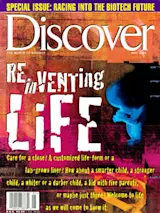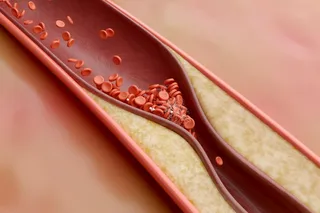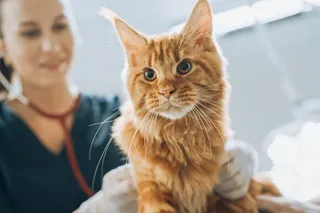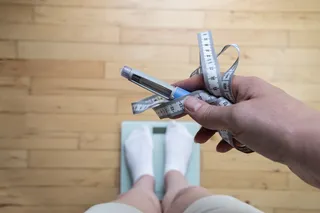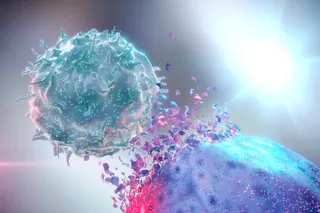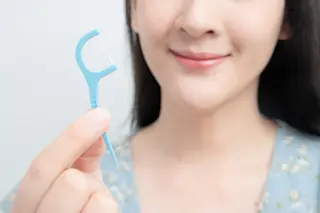Last February, when Brigitte Boisselier, a French chemist, heard that Scottish scientists had produced Dolly, a sheep cloned from an adult cell, she was one of the few researchers whom the news did not surprise. A member of a fringe religious organization called the Raelian Movement, Boisselier had expected such a development: the group’s leader, Rael, had predicted it 23 years before. It seems that Rael, a former French sports journalist, received the news of the impending discovery from extraterrestrials. They send him such announcements periodically, since he’s half E.T. himself. According to a Raelian fact sheet (which could also serve as a script for The X-Files), his mother was transported aboard a ufo, where she was inseminated by one of these otherworldly beings. In 1946, Rael was born from this union, and 27 years later he began receiving messages from the distant paternal side of his family. Most of these celebrate science and technology, predicting a future when we Earthlings will rationally understand [our] origins and begin making synthetic people. Cloning human beings, apparently, is one of the steps we must take on this path.
Rael told us this would happen, says Boisselier, so when we heard the news we weren’t shocked; we were organized. Indeed, so organized that one month later—even as medical ethicists, politicians, and pundits debated whether the technique should ever be applied to humans, and President Clinton asked for a moratorium on such research—the Raelians launched a company called Valiant Venture Ltd., the world’s first human cloning firm. Advertised on the Web, Valiant Venture offers a service called Clonaid to help parents who want to have a child cloned from one of them. Boisselier signed on as the firm’s scientific director and is now busy overseeing experiments that she believes will lead to the first cloned human in a mere two years.
We need to do many experiments first with other species to be sure that it can be done without causing any damage, says Boisselier. And we also need to raise more funds. Nevertheless, the company, now 14 months old, is making good progress. As of late February, it had a list of more than 100 people (Raelians and nonbelievers) who would like to be cloned or to have someone they love cloned—for a minimum fee of $200,000. Boisselier claims that her firm’s research is advancing, although she would not say where the studies are taking place or who is doing them, making it impossible to verify her claims. But because the procedure can be performed in a relatively simple, inexpensive laboratory, as other scientists have noted, there is also no reason to doubt that the Raelians are doing exactly what they say: taking the first experimental steps to produce a human clone. We’ve subcontracted the work to labs where it’s legal to do this, Boisselier explains, noting that human cloning is banned in France. To say that human cloning is forbidden won’t stop the science, she says. It’s important that society knows that this is possible, that it can be—and will be—done. . . . In a few years, I expect there’ll be a lot of cloned people, that it will be done everywhere in the world. This is what happens with technological advances.
Boisselier’s outspoken enthusiasm for producing human clones is rare among scientists. Since Dolly’s appearance, only one other researcher—Richard Seed, a Chicago physicist turned biologist—has jumped publicly into human cloning. He held a press conference in early January to say that he intends to open up shop as soon as he raises the funds. Like Boisselier, he has a list of people who want to be cloned (although his is shorter, only four candidates), and he also thinks human cloning can be a reality in a rather short time and with only a few million dollars for start-up costs. But most other researchers are far more cautious, especially since they have yet to clone an adult of any of our closest relatives, other primates. These researchers regard announcements like Seed’s and Boisselier’s as not only premature but off the wall. More than one referred to Seed as a kook, an oddball simply out to make a name for himself. Seed’s announcement that human cloning was part of God’s plan for humankind [to] become one with God did not help that image.
For all their faith in science and their apparently more rigorous approach to cloning, Boisselier and the Raelians are obviously far outside the mainstream. Their offer also plays on the fears of parents, says Mark Sauer, a reproductive endocrinologist at Columbia, since they propose to store the cells of living children. These cells could be used later to produce a clone of the child should the child die. That’s exploitation of the worst kind, says Sauer. It plays on every parent’s fears. And then what about a child who’s produced that way? Will he or she be burdened by the memories of the first child? Sauer adds that he suspects in time, it will be possible to use adult cells to clone someone. But because of the many unanswered questions—both technical and ethical—human cloning has not been endorsed by anyone, and certainly not by those of us working in reproductive medicine. It’s premature to make these kinds of announcements and may lead to unwanted legislation. Indeed, as of late February, California had already banned human cloning, 24 other states were considering such laws, and eight bills were being weighed in Congress. Or cloning may be regulated by the Food and Drug Administration, which has asserted its right to do so.
Yet because cloning offers a way around certain reproductive problems—primarily by giving an infertile or homosexual couple a chance to have a biological child—most researchers agree that one day it’s likely to be an option at many fertility clinics. Human cloning, as horrific as the idea sounds to some, will happen, they say, perhaps not as soon as Boisselier and Seed estimate but far sooner than one would have guessed before Dolly trotted onto the world’s stage. It’s no longer in the realm of science fiction, says Lee Silver, a Princeton geneticist and the author of Remaking Eden, a book about cloning and other reproductive technologies. The technological breakthrough has already happened, although the details of how to do this with human cells still need to be worked out. Once they’re refined, it’ll be just a matter of time.
Those refinements are already taking place. In January, scientists from a Massachusetts firm, Advanced Cell Technology, showed off three cloned calves, Charlie, George, and Albert, which were apparently produced via a more sophisticated (and patentable) technique than the one used to produce Dolly. At human fertility clinics, researchers are pursuing studies of human eggs that could lay the groundwork for cloning, although that is not the purported intent. And the National Institutes of Health has funded two projects to clone rhesus monkeys, although only embryonic and fetal cells, not those from adults, will be used. Still, these types of studies bring human cloning closer to reality.
Good old-fashioned curiosity is pushing the field as well. Ethics aside, I have to say as a scientist I find the technological problems fascinating, says David Ledbetter, a human geneticist at the University of Chicago, voicing a sentiment others in human reproductive biology share. Why is this difficult to do? What will it take to make it work? How do you make a clone?
As ledbetter’s queries suggest, making a human clone is not simply a matter of following a recipe. The journal article announcing Dolly’s birth didn’t spell out a formula for cloning mammals; in fact, it didn’t identify the actual cell that supplied Dolly’s genetic material. Yet even without that key piece of information, Dolly’s appearance was utterly astounding, since most biologists believed that it was impossible to produce a cloned mammal using any adult cell. That’s what everyone thought, says Don Wolf, a senior scientist at the Oregon Regional Primate Research Center in Beaverton, who’s overseeing the rhesus monkey cloning project. But Ian Wilmut [the Scottish scientist who led the Dolly project] came up with a clever innovation, a neat trick that proved us all wrong.
Before Dolly, researchers thought that adult cells could not be induced to produce a clone because they are already differentiated. As a fertilized egg develops into an adult, it divides into two, then four, then eight identical cells. Soon, however, the cells begin to specialize, becoming bone or skin, nerve or tissue. These differentiated cells all share the same dna—the blueprint of the body—but they follow different parts of the instructions it contains. In a sense, they’re programmed, says Wolf, and as they age, it becomes more and more difficult to reprogram them, to make them switch functions. That’s exactly what the Scottish team did when they produced Dolly: they took the genetic material from a differentiated adult cell and made it behave like the genetic material in a newly fertilized egg. Their success, however, does not mean that it is now easy to reprogram a human adult cell. If anything, notes Wolf, researchers suspect that every species is unique in its requirements for setting its cellular clock back to zero.
Low-key and soft-spoken, Wolf stepped into the cloning spotlight last year, when the primate center announced that he had produced two monkeys, called Neti (an acronym for nuclear embryo transfer infant) and Ditto, using a technique similar to the one used to make Dolly. Despite Ditto’s name and stories in the press, the monkeys are not identical copies of each other; they are only brother and sister. They were cloned using cells taken from two different embryos that shared an egg donor and a sperm donor. Still, their existence demonstrates that the formerly unthinkable is doable—and with primates.
Further, Wolf suspects he could produce clones from adult monkey cells as well, although, he is quick to add, he’s not attempting to do so. I have no desire to compete with the Richard Seeds of this world, says Wolf. Nor do I want to see a knee-jerk reaction from our legislators that bans everything we’re trying to do, particularly with techniques that have such tremendous potential for biomedical research. Already Congress has made research on human embryos off-limits to anyone receiving federal grants. Those who do not comply will have their labs shut down. It’s safer, Wolf and others say, simply to avoid the subject.
Wolf retired from the primate center in 1996; he came back only after receiving the two nih grants to produce a series of cloned monkeys for medical research and is now setting up his new lab. When complete, it will occupy three rooms in one of the center’s squat beige buildings. In one, two researchers dressed in lab coats are peering through their microscopes at petri dishes filled with pinkish masses of monkey tissue. Somewhere in the gelatinous mix are the eggs, each about five-thousandths of an inch across. The researchers’ task is to pluck out the good ones gently with a thin glass tube called a micropipette, then place these in a fresh dish for later use. Judging from the back and neck stretches the duo indulge in during a break, their efforts require almost as much concentration as trying to induce a spoon to bend. This is going to be the main place of activity, Room 003, says Wolf, pausing briefly to check on his group’s progress, then leading the way outside, where tall pines and firs tower overhead.
Wolf moves through the lushly landscaped grounds to a nondescript conference room, where he pulls up a chair and begins explaining the enormous boon genetically identical monkeys will be to medical researchers trying, for example, to develop an aids vaccine. They’d be an ideal model system, says Wolf, since they’d have identical immune systems, eliminating an important potential cause of confusion when scientists test such a vaccine or other treatment.
The center already raises rhesus monkeys for medical research; most are used in experiments here and some are sold to other medical research institutions. While awaiting their fate, the monkeys live in grassy two-acre enclosures where they pick at the grass, climb tree stumps, play, and mate, keeping an eye out for their feeders. From a distance and to the uninitiated, they all look so much alike they could easily be clones. When mature, Neti and Ditto will join one of these troops. For the time being, they’re kept with other young monkeys in a smaller yet roomy cage, although no one seems sure which cage they’re in or if they’re even in the same one. Since their brief moment of celebrity, they’ve been treated like any other adolescent monkeys at the center, and since they apparently look like the other adolescents, they are no longer singled out for show.
To make neti and ditto, Wolf followed a procedure that has frequently been used in the cattle industry for producing prized breeds. It is not, however, easily done; even in cattle, only 1 to 4 percent of such pregnancies yield offspring. In light of that low percentage, Wolf’s first efforts represented a tremendous success, says Dee Schramm, a reproductive physiologist at the Wisconsin Regional Primate Research Center in Madison. From 52 transplanted embryos, Wolf produced two healthy monkeys. Yes, that’s encouraging, Wolf acknowledges, but you really can’t draw any conclusions or expectations from what we did. After all, we’ve only done it twice. Still, the success has encouraged Schramm and his colleague David Watkins to attempt to clone rhesus monkeys themselves. They, too, have an nih grant for work using fetal and embryonic cells. They also plan to produce monkey embryos from adult cells, to study the differences in embryonic development among clones produced from different sorts of cells. However, they won’t implant embryos produced from adults into female monkeys; only clones made from fetal and embryonic cells will be carried to term. Schramm says he hopes to have several pairs of identical monkeys over the next two years. The work is so slow and tedious, he adds, that I don’t foresee any monkey cloning factories.
That’s because it’s tricky to reprogram any differentiated cell, whether embryonic or adult. To turn a cell’s clock back to zero, researchers like Wolf and Schramm use a technique called nuclear transfer technology. This is the basic method that produced Dolly, Neti and Ditto, and the three identical calves. In all three cases, the scientists removed an egg’s nucleus (that is, its dna, the genetic material that makes each individual unique) and replaced it with the nucleus from another cell. For Dolly, the nuclear material came from an adult cell; that of Neti and Ditto came from two separate embryos; and the calves’ was derived from the cells of a single fetus. In all cases the cuckooed eggs were then persuaded to grow and divide normally.
That’s the straightforward part of the formula. In between lies a minefield of potential problems, many unique to whatever species is being cloned. We’re not following a recipe, says Wolf. The conditions under which the embryos grow vary widely: each animal has its own required temperature, for example. And an embryo’s cells begin to differentiate at different moments for different species. Sheep, calves, monkeys, and humans all reach the eight-cell stage before they start differentiating, but mice begin when the embryo consists of only two cells, which is why no one is cloning them. There’s also a lot of variation among mammalian species just in the size and nature of the egg, Wolf adds. In some mammals, such as pigs, eggs are dark in color, making it hard to tell if they are viable. While that’s not a problem for manipulating rhesus monkey or human eggs, where any discoloration means the egg is dead, simply getting the eggs is. You can get buckets of eggs from slaughterhouses for livestock species, explains Schramm. But every egg you get from a monkey is worth its weight in gold.
In the case of Neti and Ditto, eggs were first harvested from several rhesus females whose ovaries had been stimulated with hormones. You give them hormone shots twice a day for eight days, says Schramm, and then, if you’re lucky, maybe you get 20 eggs. Out of these, 16 may be mature. And from these 16, perhaps 12 will be fertilized. The eggs are fertilized by placing them in a dish with the male monkeys’ sperm, and the resulting cells are grown in a nutrient broth under what Wolf terms well-defined conditions; this is something we know a lot about from human infertility studies and that can be applied to our monkeys. Each embryo is allowed to grow for three days, dividing into eight cells. At this stage, all the cells are still identical to one another and largely unprogrammed. Theoretically, you could produce a complete individual from each of these cells, says Wolf, giving you eight identical monkeys. But only theoretically, because most do not survive the coming manipulations.
In the next step, the cells, called blastomeres, are carefully teased apart; they constitute the donor nuclei. Each one, explains Wolf, is really one-eighth of an embryo, but that one-eighth contains the key ingredient: the nuclear dna, all that’s apparently needed to get the process ticking again.
You might expect that geneticists could divide each embryo into eight blastomeres, wait for each blastomere to grow into an eight-cell embryo, and repeat the process indefinitely. But that’s not possible, says Wolf, because the embryo’s cells begin differentiating into limbs and organs after a certain amount of time has passed since its development began, regardless of how many cells it has. An embryo grown from a blastomere will have only an eighth as many cells to work with as an entire embryo; if you divided it again, it would have only a sixty-fourth as many cells. As development proceeds, when time for it to differentiate arrives, it doesn’t have enough cells for the job, says Wolf, and even a blastomere will be less viable than an entire embryo. Because the cues to develop come from the cell’s cytoplasm—the material that fills the cell—rather than the nucleus, the blastomere’s clock can be reset by transferring its genetic material to a new egg full of fresh cytoplasm.
Using micropipettes, the scientists remove and discard the nuclear dna from another batch of rhesus monkey eggs. That leaves the cytoplast—that is, the egg’s membrane and the material that once surrounded its chromosomes. A donor cell, one of the blastomeres, is then placed next to the chromosome-free egg in a petri dish. In normal fertilization, an egg is in a quiescent state at the time it is ovulated, says Wolf. The sperm triggers the egg to be activated, and the cytoplasm starts the program of events that will lead to development. But here, we aren’t giving the cytoplast any sperm, so we must artificially stimulate the two cells with a chemical treatment. A pulse of electricity then causes the two cells to fuse, and a reconstituted embryo is formed. The order of these two steps, however, was reversed when the Massachusetts researchers at Advanced Cell Technology cloned their calves; and the chemical treatment was apparently bypassed altogether when Dolly was made. It could be species differences, or it could be artifacts of the lab, says Wolf. It’s too early to say.
Once we have the embryo, we can treat it as we do any other, he continues. Most often we freeze them until we have a monkey ready for an implant. That’s the other big hurdle—making sure that the recipient monkey is at the right point in her cycle for the embryo to take. Prospective recipients are monitored for several weeks beforehand. To do the actual transfer, a veterinarian surgically places the embryo into the monkey’s oviduct. Women have short, straight cervixes, explains Wolf, so surgery isn’t required when embryos are transplanted at fertility clinics. But a monkey’s cervix is tortuous, and the only way we can implant the embryos is surgically, although we’re trying to come up with other methods.
At the end of all this labor, only eight twins can be produced, and that’s assuming that every transfer succeeds, which is pie in the sky, says Wolf. It’s not the optimal method, although we used it to make Neti and Ditto. But Wolf wants a series of clones, and for this, he says, we need a lot of identical nuclei. He expects to retrieve these donor nuclei from the cells of fetal monkeys, such as their embryonic stem cells (undifferentiated precursors for other cell types) or fibroblasts (the cells that form the body’s connective tissue, which are commonly grown in labs). Both kinds can be propagated in large numbers in test tubes, making it possible, he says, to produce a clone size that is infinite in number. In other words, he expects to turn out identical monkeys, like a copying machine with a jammed on switch. We don’t know yet if we can do this; that’s what we’re working on now. And in fact, this same technique—growing a line of fetal cells for subsequent nuclear transfer—enabled researchers at Advanced Cell Technology to produce the identical calves. It’s a very efficient method for us already, says Steven Stice, the firm’s chief scientific officer. We’re producing more viable embryos than we have cows to put them in. (Oddly, the company has had no luck cloning a pig. They are very different from cattle, says Stice. Every step has to be reevaluated. We’re not sure what we’re doing wrong.)
Scientists first began trying to clone animals using adult cells in 1938, when the German embryologist Hans Spemann proposed making a clone by removing an egg’s nucleus and replacing it with the nucleus from another cell. Those efforts failed until the 1970s, when frogs were finally cloned via the nuclear transfer method. None of the cloned frogs, however, made it past the tadpole stage. And that’s where the idea of adult cloning stayed until Dolly arrived.
It couldn’t be done; that was what everyone said, explains Wolf, which is why this was such a revolutionary discovery. The Scottish team found a way to reprogram that adult cell. They did so by starving the adult cells, thus inactivating them. Wilmut began with a vial of frozen cells taken from the udder of a six-year-old sheep. His team thawed them and placed them in a growth serum with only minimal nutrients for five days. That’s the trick that made all the difference, says Wolf. The adult cells were then fused with 277 different eggs. Out of all these attempts, only one lamb was born: Dolly. That tells you that something was desperately wrong with the other 276, says Steen Willadsen, an embryologist at St. Barnabas Medical Center in Livingston, New Jersey.
Because of this low success rate, we’re a long ways off from getting adult cloning to work on a regular basis even in domestic animals, adds Lawrence Layman, a reproductive endocrinologist at the University of Chicago. It’d be highly unethical at this stage to try it in humans, since the probability of miscarriages and birth defects is high. Stice agrees: It’d be complete folly. We’ve used hundreds of thousands of eggs in cattle over the last ten years to achieve these results. To start at ground zero now with humans would be morally wrong and misguided.
Some researchers worry too that damage from aging dna may be passed on to the cloned infant. It’s going to be very instructive, watching Dolly age, says Julian Leakey, a biochemist at the National Center for Toxicological Research in Jefferson, Arkansas. If she goes through puberty, she may be okay. But she might also have acquired some random genetic mutation that could lead to problems early in life. That’s the potential danger of cloning adults, says Leakey, which is why it would be useful to do controlled tests in short-lived mammals, such as rodents, first. Then you could work out the odds of using aged tissue versus young tissue for cloning.
There are other unanswered questions. It’s not clear which cells were used to make Dolly. They don’t know which cell from the udder worked, or why it worked, says Ledbetter. That’s a big gap, and it means we don’t have any idea if every cell type will work or only certain ones. Some researchers even question that it was an adult cell at all: the udder cells were taken from a pregnant sheep, and fetal cells are known to circulate in a mother’s body. Nor do researchers know if the serum starvation trick will work with other species.
Despite the difficulties, says Willadsen, the technique will be—is being—perfected . . . somewhere. And once that happens, it’s only a matter of time before we see the first cloned humans—individuals who are a physical copy, or twin, of their mother or father, but separated by at least a generation. When that first cloned child is born, not only will no one know that he or she is different, says Lee Silver, no one will know that he or she is a clone. People will probably say things like, ‘Oh, you look so much like your mother [if she was the nucleus donor],’ and she’ll smile. But no one will know, at least not until the kid is 16 and decides to sell her story to the tabloids for a million dollars.
From studying twins that were separated at birth and raised in different families, researchers surmise that such clones will also be likely to share intellectual abilities and personality traits with their sole biological parent. Clones may thus follow in the footsteps of their parent—but only in a very general way. They will be separated by an entire generation, notes Sandra Scarr, a professor emerita of psychology at the University of Virginia in Charlottesville. And as we all know, the cultural and social circumstances of the next generation are never the same as those of the preceding one. It’s those social attitudes that shape a person’s view of the world, including everything from how you view the stock market to the excesses of war. So the clones may be similar in intellect and personality, but their content will be different. Identical twins reared in the same house, she notes, listen to the same bedtime stories, eat at the family table together, attend the same schools, have the same friends and teachers. The clone and its parent, however, will share none of these experiences. And these are the kinds of things that influence how one expresses one’s genetic potential.
People think it’s going to be a robot or automaton, says Thomas Bouchard, who’s led the long-term twin studies at the University of Minnesota. Nothing could be further from the truth. They’ll be their own persons, and that’s why the idea of cloning doesn’t bother me in the least. It’s nonsense to be afraid of it. Yet because of this culturally ingrained idea of what a clone is, some ethicists are concerned that the parent of a clone may try to exert excessive control over the child. Parents already control their children to an extraordinary degree, says Lori Andrews, a law professor at the Chicago-Kent College of Law. Will these clones be held in some kind of genetic bondage to their parent? They might put undue pressure on the child to grow up in a certain way, so that it really doesn’t have its own identity.
Other researchers question how similar the clones will be, even physically. We already know from studying monkeys and children that there’s considerable variation at birth, says Christopher Coe, a psychologist at the University of Wisconsin in Madison. Coe intends to explore this variation with the cloned rhesus monkeys that his colleagues Watkins and Schramm are attempting to produce. Since the cloned embryos will be implanted in different mothers, they’ll give us the best opportunity we’ve ever had to clarify what we mean by nature versus nurture, says Coe. It’s the project I’ve dreamed about since graduate school, 20 years ago.’’ For instance, how different will a cloned monkey that’s implanted in an older mother be from one that’s grown in a younger mother? To what degree do in utero influences affect the development of the baby? asks Coe. And how much do the mother’s actions, what she eats, and whether or not she’s dominant or submissive, influence her baby’s growth? The prenatal environment plays a far bigger role in shaping a baby than most people realize. The cloned monkeys, he believes, will probably look alike (although they could also differ in such things as their weight at birth) but will nevertheless be quite different.
Other research on human twins also suggests that such things as how early the cells divide into twins and where the twins are placed in the uterus affect how identical they are after birth. I think that’s the real question: Just how different will these cloned babies be at birth, despite being genetically identical to their parent? adds Coe. In an effort to establish the cloned monkeys’ individuality, he will be measuring everything from their birth weight to how quickly they hold up their heads and how long they nurse.
Then too there’s the question of the influence of the mitochondrial dna. Not all of a cell’s dna is found in the nucleus; the mitochondria, tiny organs a cell uses to transform food into energy, have their own dna. Although the donor egg will receive a new nucleus, it will retain its mitochondrial dna, which may well be different from the donor’s. It’s only a small amount of genetic variation, but it’s there, says Silver, though, he adds, there is nothing in the mitochondrial dna that matters in making us different from each other.
In short, cloning yourself will not roll the clock back. It will not produce your soul mate and may not even give you your complete identical twin. What it will do is give you a baby that is more biologically related to you than anyone else. And that, says Silver, is why cloning will happen and few people will harshly judge those with infertility problems who choose it as a way to reproduce. It’s instinctive, I think, to want to have a biological child. That’s what cloning offers—a chance for some people to have what they thought they never could have: a child of their own.


